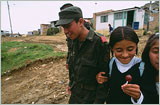|
ROOTS
OF CONFLICT
Colombia, with a population of 40 million, has been steeped in war
for almost 50 years, making the exact roots of the violence sometimes
hard to fathom, even for those putting their lives on the line.
The symptoms may be more easily identified. According to the government’s
own estimates, 55 percent of the population lives below the poverty
line, defined as household income of less than $280 per month. Unemployment
has soared to record levels, with official estimates hovering close
to 20 percent, the highest in the hemisphere. Even in times of plenty,
rampant corruption and state centralization have deprived remote
communities of schools, health facilities, and other basics. Potholed
dirt tracks are frequently the only lifeline to the outside world.
With social justice as their founding battle cry, Colombia’s
leftist rebel factions took up arms against the state in the mid-1960s.
The two main Marxist guerrilla forces are the FARC (Revolutionary
Armed Forces of Colombia), with around 17,000 combatants, and the
ELN (National Liberation Army), with around 5,000 fighters. Both
groups bankroll their war effort through extorsive kidnapping; the
FARC draws much of its income through taxes on the drug trade. Militarily
weaker, the ELN specializes in economic sabotage, like blowing up
oil wells and pipelines. The ELN’s historically hardcore Domingo
Laín Front this year bombed Colombia’s second-largest
crude oil export pipeline more than 100 times, causing a subsequent
drop in oil exports, the country’s biggest earner. Economic
analysts are already predicting that Colombia will not reach its
3.8 percent growth target in 2001, mandated as part of a loan deal
by the International Monetary Fund.
The core demands of both groups center on a sweeping agrarian reform,
a radical redistribution of wealth, and an end to freemarket economic
policies, including a greater state role in key industries.The FARC
has gained a reputation of being more radical largely due to its
almost exclusively peasant membership and hierarchical politico-military
structure. Concentrated largely in rural areas, the insurgents are
currently estimated to control up to 50 percent of the country –
most of that in the hands of the FARC.
The nationwide alliance of outlaw, right-wing paramilitary forces
known as the United Self-Defense Forces of Colombia (AUC), currently
musters some 8,100 gunmen, of mainly working-class stock. They are
funded by a mixture of wealthy landowners, industrialists, politicians,
urban upper middle-classes, and drug traffickers.
According to government figures:
-
In the last decade, 35,000 civilians have died as a result of
the war, many of them massacred by gunmen of the left and right.
-
Over just the last five years, more than 1.1 million people have
been displaced by the violence, the majority of those by right-wing
paramilitary gangs.
-
In the year 2000, more than 3,700 civilians were abducted –
confirming the country’s status as kidnap capital of the
world. The majority of snatches are attributed to the guerrillas,
who stuff their war chests with at least $150 million a year in
ransoms.
There
is no broad consensus on the cost of the war in financial terms.
Government planners have consistently estimated it is costing the
equivalent of about four percent of gross domestic product (GDP)
in this Andean nation, which is the fifth largest economy in Latin
America with an annual GDP of around $80 billion.
|

Young men doing their military service as policemen patrol a refugee
community on the outskirts of Bogotá, Colombia's capital.
Soacha,
Colombia.
|


